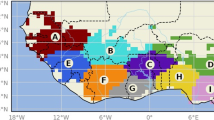Abstract
In this paper we demonstrate the need for risk-adjusted approaches to planning expansion of livestock production. In particular, we illustrate that under exposure to risk, a portfolio of producers is needed where more efficient producers co-exist and cooperate with less efficient ones given that the latter are associated with lower, uncorrelated or even negatively correlated contingencies. This raises important issues of cooperation and risk sharing among diverse producers.
For large-scale practical allocation problems when information on the contingencies may be disperse, not analytically tractable, or be available on aggregate levels, we propose a downscaling procedure based on behavioral principles utilizing spatial risk preference structure. It allows for estimation of production allocation at required resolutions accounting for location specific risks and suitability constraints. The approach provides a tool for harmonization of data from various spatial levels. We applied the method in a case study of livestock production allocation in China to 2030.
Similar content being viewed by others
References
Bierkens, M., Finke, P. & de Willigen, P. (2000). Upscaling and Downscaling Methods for Environmental Research. Kluwer, Dordrecht, The Netherlands
Bregman, L.M. (1967). Proof of the convergence of Sheleikhovskii’s method for a problem with transportation constraints. Journal of Computational Mathematics and Mathematical Physics, 7(1): 191–204 (In Russian, Zhournal Vychislitel’noi Matematiki, USSR, Leningrad, 1967)
Cao, G.Y. (2000). The future population of China: Prospects to 2045 by place of residence and by level of education. Interim Report IR-00-026, International Institute for Applied Systems Analysis, Laxenburg, Austria
CCAP (2002). Estimates of province-level meat production and consumption, 1980–1999: Database prepared for CHINAGRO project. Center for Chinese Agricultural Policy, Beijing
Dantzig, G. & Madansky, A. (1961). On the solution of two-stage linear programs under uncertainty. In: Proceedings of Fourth Berkeley Symposium on Mathematical Statistics and Probability: 165–176, 1961, Univ. California Press, Berkley
Ermolieva, T. & Ermoliev, Y. (2005). Catastrophic risk management: flood and seismic risks case studies. In: Wallace, S.W., Ziemba, W.T. (eds.), Applications of Stochastic Programming, pp. 425–445. MPS-SIAM Series on Optimization, Philadelphia, PA, USA
Ermoliev, Y. & Fischer, G. (1993). Spatial modeling of resource allocation and agricultural production under environmental risk and uncertainty. Working Paper WP-93-11, International Institute for Applied Systems Analysis, Laxenburg, Austria
Ermoliev, Y. & Leonardi, G. (1981). Some proposals for stochastic facility location models. Mathematical Modeling, 3: 407–420
Ermoliev, Y. & Wets, R. (eds.) (1988). Numerical Techniques for Stochastic Optimization: Computational Mathematics. Springer Verlag, Berlin
Fang, G., (2001). Urbanization: a center of Chinese economic growth in the next phase. Available at http://www.curb.com.cn
FAO (2004). Fertilizer requirement in 2015 and 2030 revisited. FAO, Rome
FAOSTAT (2002). FAOSTAT data. FAO, Rome. Available at http://faostat.fao.org
Fischer, G., Ermolieva, T., Ermoliev, Y. & van Velthuizen, H. (2006). Sequential downscaling methods for estimation from aggregate data. In: Marti, K., Ermoliev, Y., Makovskii, M., Pflug, G. (eds.), Coping with Uncertainty: Modeling and Policy Issue. Springer Verlag, Berlin, New York
Fischer, G., Ermolieva, T., Ermoliev, Y. & van Velthuizen, H. (2005). Spatial recovering of agricultural values from aggregate information: sequential downscaling methods. In: Makowski, M., Wang, Z., Nakamori, Y., Wu, J. (eds.), Sixth International Symposium on Knowledge and Systems Sciences (KSS2005): 29–31, IIASA, Laxenburg, Austria
Fischer, G., Ermolieva, T. & van Velthuizen, H. (2006). Livestock production and environmental risks in China: scenarios to 2030. FAO/IIASA Research Report, International Institute for Applied Systems Analysis, Laxenburg, Austria
Fisher, R.A. (1922). On the mathematical foundations of theoretical statistics. Philosophical Transactions of the Royal Society of London, Series A222: 309–368
Golan, A., Judge, G. & Miller, D. (1996). Maximum Entropy Econometrics: Robust Estimation with Limited Data. Series in Financial Economics and Quantitative Analysis. John Wiley & Sons Ltd, Baffins Lane, Chichester, West Sussex PO19 1UD, England
Huang, J., Zhang, L., Li, Q. & Qiu, H. (2003a). CHINAGRO project: national and regional economic development scenarios for China’s food economy projections in the early 21st century. Report to Center for Chinese Agricultural Policy, Chinese Academy of Sciences, Beijing
Huang, J. & Liu, H. (2003b). Income growth and lifestyle. CHINAGRO Internal Working Paper WP 1.7., Center for Chinese Agricultural Policy, Chinese Academy of Sciences, Beijing
Karlqvist, A., Lundqvist, L., Snickars, F. & Weibull, J.W. (1978). Studies in Regional Science and Urban Economics: Spatial Interaction Theory and Planning Models. North-Holland Publishing Company, Amsterdam, New York
Keyzer, M.A. & van Veen, W. (2004). A summary description of the CHINAGRO-welfare model. CHINAGRO Report, SOW-VU, Free University, Amsterdam, The Netherlands
Kullback, J. (1959). Information Theory and Statistics. John Wiley & Sons, New York.
Liang, Y. (2002). Spatial allocation of agricultural production using a generalized cross entropy approach. Draft Report
Ma, H., Huang, J., Rozelle, S. & Rae, A. (2004). Chinese animal products consumption in the 1990s. Australian Journal of Agricultural and Resource Economics, 48(4): 569–590
Ricardo, D. (1822). On Protection in Agriculture. John Murray, London
Shannon, C. (1948). A mathematical theory of communication. Bell System Technology Journal, 27: 379–423
Simpson, J.R., Cheng, X. & Miyazaki, A. (1994). China’s livestock and related agriculture: Projections to 2025. CABI Bookshop
SSB (2001). Statistical Yearbook of China 2001. State Statistical Bureau People’s Republic of China
SSB (2002). Statistical Yearbook of China 2002. State Statistical Bureau People’s Republic of China
USDA Economic Research Service (1998). China’s livestock sector growing rapidly. Agricultural Outlook
Wald, A. (1949). Note on the consistency of the maximum likelihood estimate. Annals of Mathematical Statistics, 20: 595–601
Wilson, A.G. (1970). Entropy in Urban and Regional Modeling. Pion Limited, 207 Brondesbury Park, London, NW2 5JN
Wood, S., Sebastian, K. & Scherr, S. (2000). Pilot analysis of global ecosystems: agroecosystem. Report on a Joint Study by International Food Policy Research Institute and World Resource Institute, Washington D.C
Author information
Authors and Affiliations
Corresponding author
Additional information
Günther Fischer is leader of the Land Use Change and Agriculture (LUC) Program at International Institute for Applied Systems Analysis (IIASA, Laxenburg, Austria), focusing on global climate change impacts and adaptation, on selected regional analyses in Asia and Europe to support sustainable and efficient use of land and water resources, and on development of analytical tools. He earned degrees in mathematics and in data/information processing from the Technical University, Vienna, and joined IIASA in 1974. He was a major contributor to IIASA’s studies on welfare implications of trade liberalization in agriculture, on poverty and hunger, and on impacts of climate change on food production, consumption and trade. In 2002, he led a special study commissioned by the United Nations for the World Summit on Sustainable Development in Johannesburg assessing ecological-economic impacts of Climate Change and Agricultural Vulnerability. Recently, he contributed to the Millennium Ecosystem Assessment as a Lead Author on food systems responses.
Tatiana Ermolieva has MSc in applied mathematics with specialization in statistics, optimization, economics from Kiev’s State University and Ph.D. from Institute of Cybernetics, Kiev, Ukraine. Dr. Ermolieva is affiliated with the Land Use and Agriculture Program at IIASA. Her main scientific research topics include modeling of complex socio-economic, environmental, and financial systems in the presences of uncertainties and risks, in particular of extreme catastrophic nature. Recent practical applications and scientific publications cover problems of spatial estimation and downscaling of aggregate agricultural values; agricultural production planning under risks and uncertainties; fast Monte Carlo optimization for insurance and mitigation of catastrophic losses; population aging, globalization and economic growth under demographic and economic shocks. Dr. Ermolieva received the Kjell Gunnarson’s Risk Management Prize of Swedish Insurance Society and the Dr. Aurelio Peccei Award of the International Institute for Applied Systems Analysis.
Yuri Ermoliev graduated from Kiev State University, Department of Mathematics. He received his Ph.D. in applied mathematics from the same university. Dr. Ermoliev holds the State Award in Science both of the Ukraine and of the USSR. He is a Member of the Ukrainian Academy of Sciences. Dr. Ermoliev has been Head of the Department of Mathematical Methods of Operations Research at the Institute of Cybernetics of the Ukrainian Academy of Sciences, Kiev. From 1979 to 1984 he was employed at IIASA undertaking research in non-differentiable and stochastic optimization problems. In 1991 he was a visiting professor at the University of California at Davis and returned to IIASA as co-leader of the Risk, Uncertainty and Complexity Project. Dr. Ermoliev’s publications concern stochastic optimization methods and models, path-dependent adaptation processes, pollution control problems, energy and agriculture modeling, reliability theory, and optimization of discontinuous systems subject to abrupt changes and catastrophic risks.
Harrij van Velthuizen is senior scientist in the Land Use Change and Agriculture Program at IIASA. Harrij van Velthuizen is land resources ecologist and specialist in agro-ecological zoning. He was a member of the working group that developed FAO’s Agro-Ecological Zones (AEZ) methodology. In the capacity of senior consultant and chief technical advisor of various organizations of the United Nations he has done extensive work on agro-ecological assessments for agricultural development planning covering over twenty countries in Asia, Africa, South America and Europe. Since 1995, Dr. van Velthuizen has been engaged with the activities of the IIASA’s Land Use Change and Agriculture Program. In 2001, he joined IIASA as research scholar and worked on enhancement of the AEZ methodologies for various applications including agricultural and forest production potentials and impacts of climate variability and climate change on food security.
Rights and permissions
About this article
Cite this article
Fischer, G., Ermolieva, T., Ermoliev, Y. et al. Livestock production planning under environmental risks and uncertainties. J. Syst. Sci. Syst. Eng. 15, 399–418 (2006). https://doi.org/10.1007/s11518-006-5018-2
Issue Date:
DOI: https://doi.org/10.1007/s11518-006-5018-2




